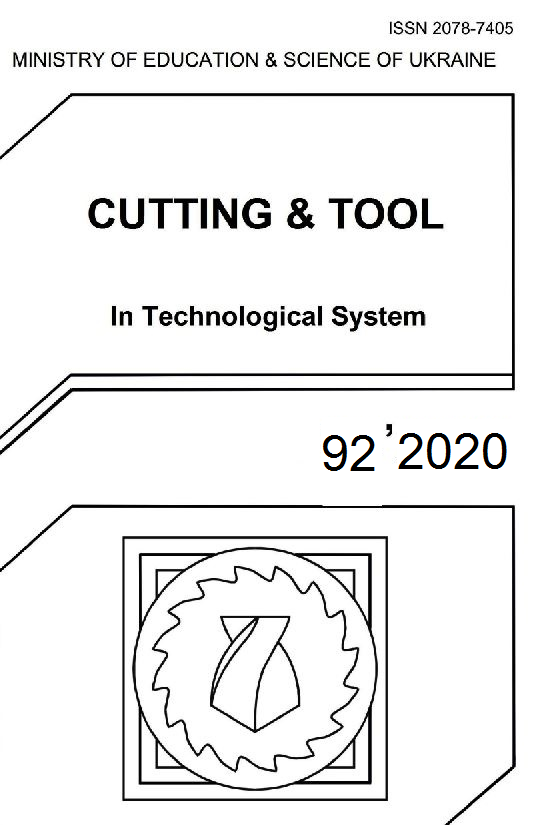ELEMENTS OF APPROACH TO INCREASE RELIABILITY OF CUTTING TOOLS FAILURES RECOGNITION
DOI:
https://doi.org/10.20998/2078-7405.2020.92.24Keywords:
failures of cutting tools, recognition, informative features.Abstract
The work is devoted to solving the problem of increasing reliability of cutting tools failures recognition. For this is proposed to carry out the following developments: the formation of sets of direct and indirect features of cutting tools states and failures; forming the corresponding state spaces; reducing their dimensionality by selecting the most informative features; construction of failures classifiers and necessary decision rules. The analysis of methods for selecting failures informative features is carried out, and the genetic method of features selecting is recommended for use.References
Mamalis, A. G. (2006). “Modern aspects of advanced manufacturing”, Suchasnі tehnologіi u mashinobuduvannі, [Modern technologies in mechanical engineering], Vol, 2, Kharkiv, Ukraine, NTU “KhPI”, pp. 58-73.
Saravanan, R., Asokan, P. & Sachithanandam, M. (2001). “Comparative analysis of conventional and non-conventional optimization techniques for CNC turning process”, International Journal of Advanced Manufacturing Technology, Vol. 17, Issue 7, pp. 471-476. doi: 10.1007/s001700170146.
Liang, S. Y., Hecker, R. L. & Landers, R.G. (2004). “Machining process monitoring and control: The state-of-the-art”, Journal of Manufacturing Science and Engineering, Transactions of the ASME, Vol. 126, Issue 2, pp. 297-310. doi:10.1115/1.1707035.
Zhang, X., Tsang, W.-M., Yamazaki, K. & Mori, M. (2013). “A study on automatic on-machine inspection system for 3D modeling and measurement of cutting tools”, Journal of Intelligent Manufacturing, Vol. 24, Issue 1, pp. 71-86. doi: 10.1007/s10845-011-0540-6.
Lu, Z., Ma, P., Xiao, J., Wang, M. & Tang,X. (2019). “On-line Monitoring of Tool Wear Conditions in Machining Processes Based on Machine Tool Data” Zhongguo Jixie Gongcheng, China Mechanical Engineering, Vol. 30, Issue 2, pp. 220-225. doi: 10.3969/j.issn.1004-32X.2019.02.013.
Derevianchenko A., Fomin A. (2019) Elements of information support of cutting tools dynamics analysis / Cutting and Tools in Technological Systems. Kharkiv: NTU «KhPI». V. 91 – pp. 14 – 23. doi: 10.20998/2078-7405.2019.91.02.
Derevianchenko O., Fomin O. (2019) Intelligent systems for CNB tools states hardened steel turning. Conference Book of ICACMCT-2019 (International Conference of Advanced Coating and Materials for Cutting Tools), November 21 – 23, Taizhou University, Zhejiang, China.
Fomin, O., Pavlenko V., Derevianchenko O., Vodichev V., Ruban O. (2019) An approach to the construction of a nonlinear dynamic model process cutting for diagnosis condition of tools. Applied Aspects of Information Technology, № 2(03), pp. 115–126. doi://10.15276/aait.02.2019.3.
Povoroznyuk, A.I. & Somova, A.A. (2008). Formirovanie sistemy informativnyh diagnosticheskih priznakov na osnovanii kolichestvennogo vyrazhenija ih znachimosti, [Formation of a system of informative diagnostic features based on a quantitative expression of their significance], Herald of the National Technical University “KhPI”, Series of “Informatics and Modeling”, No. 24, pp. 137-141.
Lenkov, S., Zhyrov, G., Zaitsev, D., Tolok, I., Lenkov, E. (2017). “Features of modeling failures of recoverable complex technical objects with a hierarchical constructive structure”, Eastern-European Journal of Enterprise Technologies, Vol 4, No. 4 (88), pp. 34-42. doi: 10.15587/1729-4061.2017.108395.
Subbotin, S. & Oliinyk, A. (2017). “The Sample and Instance Selection for Data Dimensionality Reduction, Recent Advances in Systems, Control and Information Technology”, Advances in Intelligent Systems and Computing, Vol. 543, pp. 97-103. doi: 10.1007/978-3-319-48923-0_13.
Downloads
Published
Issue
Section
License
Copyright Notice
Authors who publish with this Collection agree to the following terms:
1. Authors retain copyright and grant the Collection right of first publication with the work simultaneously licensed under a Creative Commons Attribution License that allows others to share the work with an acknowledgement of the work's authorship and initial publication in this Collection.
2. Authors are able to enter into separate, additional contractual arrangements for the non-exclusive distribution of the Collection's published version of the work (e.g., post it to an institutional repository or publish it in a book), with an acknowledgement of its initial publication in this Collection.
3. Authors are permitted and encouraged to post their work online (e.g., in institutional repositories or on their website) prior to and during the submission process, as it can lead to productive exchanges, as well as earlier and greater citation of published work.

